Not only did I see a fat biker, but I also have a good snowshoe story to tell you(later). The last I heard, fat bikes weren’t allowed on the groomed ski trails.
I was glad to hear that PLPP is using the Ribbon Creek snowcat to groom the trails while theirs is in the repair shop.
What you need to know for tomorrow: The first 3K on Elk Pass will have glazed tracks.
When I started out at 1:30 pm, the snow was clean and in good shape. I was able to get decent grip with the VR45(-2/-8) which was on my skis from yesterday.
The conditions only got better the further I went. Coming back at 4:20 pm, I was amazed at how much the conditions had changed as I neared the Elk Pass trailhead. The tracks were glazed and full of snow fleas.
With the temperature dropping down to -11°C tonight, the tracks will be extremely icy in the morning. The forecast high for tomorrow is -3, so I don’t know if they will ever soften up. Check the Live Grooming Report in the morning to see where tonight’s tracksetting occurs. That might be a better choice. If it snows a couple cm tonight, that changes everything.
I saw lots of evidence today of skis icing and clumping. On Tyrwhitt, using my mantracker skills, I observed where one skier finally gave up and carried his/her skis.
I can’t believe the good luck I’m having with wax lately. My wax, which was left over from yesterday, didn’t give me great grip up the big Elk Pass hill but it was adequate. I expected conditions to improve as I got further out, and they did. If I had waxed with something stickier to climb the big hill, then I would have been experiencing “high-heels” later.
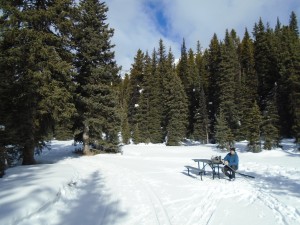
It was nice and sunny at the Tyrwhitt picnic table. I stopped here to have a snack and chat with Chris.
I skied to the top of Elk Pass(6K) and continued on for 3.6K to the high point on Tyrwhitt. I turned around and retraced my steps back to the Elk Pass parking lot. Half way down Elk Pass I encountered the fat biker.
As I was starting out today, and had just arrived at the Elk Pass – Hydroline junction, I met Sam who was returning from the top of Elk Pass. He said he was one of the first skiers out today, and when he arrived at the Hydroline junction earlier, eight snowshoers appeared from the snowshoe trail which comes in from a different spot.
Sam pointed them towards the red trail marker with an image of a snowshoer on it, which goes up Hydroline. He said they gave him a dirty look and proceeded up the Elk Pass ski trail.
While at the junction, I talked to three snowshoers who had used the ski trail and I asked them why they preferred it over the snowshoe trail. They said they were confused and didn’t realize the snowshoe trail went up Hydroline. They said it with a straight face as we all stared at the bright red snowshoe trail marker.

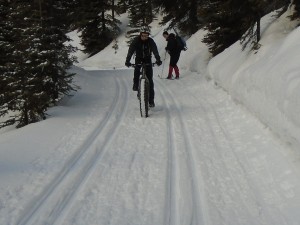
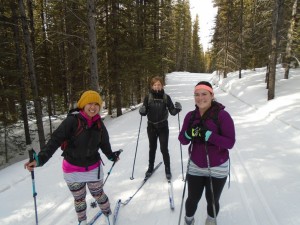
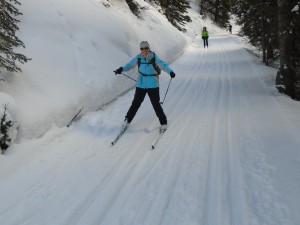

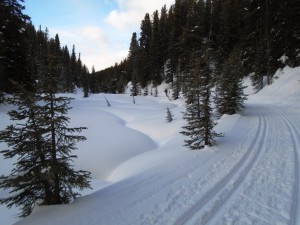


An interesting quote I stumbled upon seems to fit this discussion very well and answers the question why it affects so many people.
“Recreational conflict – a negative experience occurring when
competition for shared resources prevents expected benefits from
participation from accruing to an individual or group”; and
“Social and psychological conflict – competition for shared
resources amongst individuals or groups whose leisure activity is
mutually exclusive or has contrary objectives.”
I noticed a fat-bike track on the Blueberry Hill trail today. The rider had stayed to the right of the uphill set track all the way up and to the right of the downhill set track all the way down. The tire tracks made no more of an impact than any of the ski tracks, where skiers had stepped out of the track-setting. In fact, he did less damage than the skiers who herringboned over the track-setting. If you were passing the fat-biker going uphill, it would have been easier than passing a skier in the track ahead of you. If you were going downhill, the bike would have been easier to pass than a slower skier descending ahead of you.
If fat-bikes and snowshoers are going to share a trail, it makes much more sense to me that they remain on the outside edge of the grooming, the way this cyclist did. That’s much better than occupying the space between the tracks!
It seems to me that many reasonable options could be considered, other than just banning one activity versus another.
For Hydro-Line, it should be possible to leave enough space along one side of the grooming for snowshoes and fat-bikes.
For Elk Pass trail, is should be possible to create an adjacent snowshoe trail beside most of the ski trail… perhaps going to West Elk Pass and along the BC-Alberta border cut-line to get to the top of Elk Pass.
And perhaps some new and interesting snowshoe/fat bike loops should be created that are completely separate from the ski trails.
Well, it seems like Bob’s request “to hear from some snowshoers who could give us some insight into this phenomenon” (Feb 1) was rhetorical as responding to that has just led to snowshoers being called “ridiculous” and “bizarre.”
Complaining about non-skiers using tracked ski trails is about as useful as complaining that no one writes letters anymore. While it would be wonderful if these conflicts didn’t happen, and there were trails all over the place for each specific user group to use, that is not the case. The reality is that with increased popularity of snowshoeing and fat biking, this issue will continue and will likely get worse before it gets better.
The lack of suitable snow in places like West Bragg Creek (which I love for snowshoeing, and to me seems to have found a viable solution for multi-sport use) is forcing more and more people to use a smaller and smaller area. Overlap is inevitable.
Putting up another ‘don’t do this’ sign almost never works. Look at speed limits, stop signs, on/off leash dog areas, no smoking areas, don’t litter signs, etc and how often they are ignored. Adding the snowshoe routes to the existing maps at Fox Creek/Hydroline/Elk Pass would be helpful to alleviate confusion.
Skiers are the only ones that are negatively impacted by chewed up trails, so why not offer an alternative for snowshoers? This would benefit skiers much more than the snowshoers. The snowshoers will continue to use that area, I think we can all agree to that, and most will likely either use the Elk Pass trail (either out of legitimate confusion or out of a sense of entitlement), or use Hydroline like we did and walk along the edge of the ski trail. Bob, I’m sure you have considerable reach and influence in the winter community. Can you use your contacts to find out if Parks can run a snow cat or snowmobile up and down the side of Hydroline to pack a snowshoe trail so that there is no reason to travel right next to the ski tracks?
If it is not possible for a snow cat to make one extra pass up and down Hydroline, maybe GMJ and Pete can get together to do something positive for the skier community and show off their enviable fitness & appropriate gear selection and set a trail for the snowshoers that inevitably will come behind them.
Two other observations:
1. A greeting of “hey, did you guys know that if you take that path to the left it goes along a beautiful creek and comes out right at the bottom of the snowshoe trail” would be much more helpful than a gruff “hey you can’t snowshoe on this trail.”
2. Why would anyone ski Hydroline when they can ski Elk Pass?
Not a bad thought to make a packed trail for other users like they have at the Canmore Nordic Centre. Although I would advocate putting the track up the other side of Fox Creek because it’s way more interesting. However, it still begs the question: why not just walk? What’s the point of clunking along in snowshoes when you could walk?
Actually, I think you’re right about West Bragg. There, there are marvellous ski, snowshoe, walking and fat bike trails. However, West Bragg is the astonishing accomplishment of many organiz ers, many volunteers, and many organizers. Doing something like that at PLPP would probably be impossible, especially since it’s such a long drive from anywhere.
But (*ahem*) you’re not going to find me snowshoeing when I could be skiing.
Lastly, your first comment: I assume you’re referring to the ski trail. No, it wouldn’t be more helpful if you accomplished the opposite of what you intended. Better would be a friendly “You’re not allowed to snowshoe here, but there’s another trail you can use.”
I think that if they had decided to walk, they would have been perfectly within their rights to hike up the ski trail which would probably have caused more damage to the trail than snowshoeing. I could be wrong on this, but I couldn’t find any references to restrictions on winter hiking from a quick web search.
The rules are pretty clear that snowshoers should stay on designated trails and only use ski trails that are designated as shared and that fat biking is not permitted in PLPP and all users should abide by these, but I think that it is worth considering whether this kind of single use model is going to be sustainable going forward. It works in West Bragg, but as GMJ notes, this is only as a result of significant volunteer input that simply isn’t available anywhere else. As more and more non-skiers venture out, they are perhaps going to ask why their tax dollars are being spent on grooming trails, which then effectively prohibits them to using those trails. I really enjoy XC skiing, but recognize that it isn’t for everyone, and I wonder if it is actually declining in popularity (Calgary used to have three specialist XC ski shops, shortly it will only have one, and the Boulton Creek Trading post used to be open in the winter serving food and now isn’t possibly because of declining business) while other uses are increasing in popularity. Ultimately it seems to me that sharing the fantastic trail systems that we have with all potential users has to be the way to go, but only by changing the rules – not by users taking it upon themselves. Many of the ski trails in Banff National Park are shared with Fat Bikers, and that seems to be working satisfactorily. Those are just my thoughts and I fully respect anyone’s right to disagree.
A more interesting trail along Fox Creek sounds wonderful, but won’t help the problem of users going along next to the ski trail instead of using the posted snowshoe trail due to deep, untracked snow. And it probably wouldn’t appeal to those that are going all the way to the cabin or lakes as it would add distance to the trip.
I clunk along in snowshoes for two reasons really – one because as in this case the snow would not hold me up with just boots on, and two because it is more difficult than just walking along a path. I was out there for some badly needed exercise, not just for a stroll.
As far as I understand, you are not supposed to walk on ski trails.
I’m not convinced it is declining in popularity. I think the popularity of XC skiing got a boost from the 2010 Winter Olympics in Vancouver. Once upon a time, XC skiing was viewed by many people (especially downhill skiers) as being for “wimps.” I don’t get any of that now.
…But anyway, that’s a little off topic.
Personally, if I’m going to go for a walk, I don’t think ski trails are too interesting. Unlike walkers and snowshoers, skiers are “journey” oriented. Skiing, the act, is what’s primarily fun, and snowshoeing along a ski trail seems impossibly boring to me.
Another curious sighting at West Bragg Creek mid January 2016. My husband and I were cross country skiing on the track setwhen trail access road to Moose Loop when we encounted 3 woman on horseback. The horses were not walking on the tracks but along side and the horses were doing there business every where. I commented and one lady told me it was a multi purpose trail and obviously they don’t read signs.
I assume that you are referring to the Mountain Road. This is a multi-use trail and horses are permitted to use it, and all the other multi-use trails in West Bragg Creek, all year round. If they weren’t damaging the trackset, they weren’t doing anything wrong.
I am definitely not a fan of this, but that is how the current rules are worded. Before berating other trail users, you should make sure that you know the facts, otherwise you will simply give skiers a bad name.
They why do they have a sign at the beginnging of the cross country track (near the parking lot) whick says “NON SKIERS STAY LEFT”. Maybe you should learn to read sings toooooooooooooo! Maybe your thiinking of a different road. The track setting is not a vehicle road summer or winter.
It’s an exploration/logging road that is not currently in use. For instance, during the logging a few years ago, it was in fact used by logging trucks from SLS and was not groomed. It’s been bestowed the name “Mountain Road” as a trail. Once upon a time, it was known as Roadbed.
Actually, Mountain Road is a Shell Canada road, which is used to access pipelines and well sites when needed. The West Bragg Creek All-season Trails Plan specifies that the road is to be used as a multi-user trail, when not needed for industrial purposes. It is, in fact, the only trail that is recommended for winter equestrian use.
There are 50km of exlusive XC ski trails in the network, if you don’t want to share the trail with others.
Actually, Mountain Road IS a multi-user trail, which includes horses and dog-sleds in the winter. When there is snow (not now), that trail is groomed with a classic XC track on the north edge, a skate lane in the middle and a snowshoe, hiking, dog walking, dog sledding, fat biking lane along the south edge. Horses are not permitted on any other ski trails between Dec 1 and Mar 31.
Snowshoeing on a packed trail is ridiculous. You may as well be hiking instead! When I go out snowshoeing (I’ve been doing it for well over 30 years) i’m intent on making my own trail in deep snow where no one else has been before (off the beaten track!) Nowadays people seem to enjoy the packed trails. Either due to lack of experience or the fact that modern snowshoes don’t float as well as the old wood snowshoes. I’ll typically only use them if I’m in areas with thick trees or with a lot of deadfall, cliffs, etc, where skiing wouldn’t be possible. Skis are so much more efficient and enjoyable the rest of the time. I’d say if you are set on heading out on groomed ski trails rent or buy some skis and learn how to use them! You’ll get further faster and have a lot more fun!
I write this not to be argumentative or defensive, but for clarification and hopefully as welcomed advice to snowshoers that might also read this blog.
I was part of the group mentioned by Sam. There were two groups, two of us and a group of 5 or 6 that were backpacking in to Elk Lakes to camp overnight.
In the vein of ‘three sides to every story,’ this is our side, the truth probably somewhere in the middle and likely to be determined by the reader’s personal bias.
Despite reading every blog post I could find in preparation, I was finding imprecise and sometimes contradictory information on the difficulty of this trip and the exact location of the snowshoe trail vs the ski trail. We had just finished the descent off Elk Pass trail (which for that short section is marked as both ski and snowshoe) and were standing at the map posted at the Elk Pass/Fox Creek junction. Sam skied past us, stopped, turned around, and made the comment about there being a separate snowshoe trail. Our response was that we were aware, and even though we had just walked next to the ski trail we were not stepping on the ski tracks. The whole trip we were in single file when next to the ski tracks and careful to avoid them.
We did take the Elk Pass option for about 400 metres, and then went up Hydroline. We did this, instead of taking the snowshoe trail to the left, because all of us were not expecting the first part of the trail to be as steep as it is, and were quite winded and not wanting to do any additional unnecessary distance because we knew what to expect heading up to Hydroline. While we clearly saw the snowshoe sign to the left, we did not know that the snowshoe trail made a quick right turn after that, to parallel Elk Pass trail. We mistakenly thought that Fox Creek trail was the snowshoe trail being indicated and it looked to be going the wrong direction. On our return trip we did take snowshoe trail instead of the 400 metres along Elk Pass ski trail, and I would recommend that to all snowshoers as it is quite beautiful in there along the creek.
Once upon Hydroline we walked next to the ski tracks most of the way. The snowshoe trail along the edge of the trees was clearly signed, but at least for me physically impossible to use as I was sinking 2 to 3 feet any time I stepped off the packed trail. I don’t know if it is possible to have this done, but if the ski groomer was to make one pass up and down Hydroline to pack down an alternative route I’m sure snowshoers would gladly use that instead of being next to the ski tracks.
My other suggestion is to see if it is possible to add the snowshoe trail to the maps already in place showing the cross country ski trails. It is likely confusing to some (including myself) that the snowshoe signs don’t match up to what they are seeing on the trail maps because the snowshoe trail is not on those maps. Now that I have done the trip I know where to go & not go, but for a first timer, especially one as out of breath as I was, some clarification and simplification will probably go a long way to help alleviate these conflicts.
https://www.dropbox.com/s/za4zcdlytngwya0/Elk-Pass-GPS.jpg?dl=0
Snowshoers don’t want to walk in the snow? Bizarre. I’ll give you credit for admitting that you want to walk on a groomed trail, but I think we need a new name for this activity, because it isn’t snowshoeing.
Backcountry skiers love getting out in the untouched, pristine snow. What do snowshoers want?
Thank you very much for an excellent description of the perceptions and observations along this trail, from a snowshoe perspective. It is clear that there are a number of things that Alberta Parks can do, in terms of signage, information and trail design/management that would lead to a better experience for everyone.
People don’t ski exclusively in the ski tracks. The corduroy has a purpose.
I have a 50 year old pair of cat gut snowshoes. They float extremely well. Like everybody else, when I do use them, it’s when backcountry ski conditions are less then optimum or the terrain/trees are unsuitable for skis. And I never use them on a packed trail!
Here is a great article on issues, and info about the fatbike. http://www.pinkbike.com/news/gliders-and-riders-clash-over-ski-trail-access.html
Regarding this article Craig, I think the comments section defines the issue more in depth. Those who xc ski, understand that conflict is inevitable (along with trail damage) when allowing access to both groups. Those who don’t xc ski feel entitled to access anywhere.